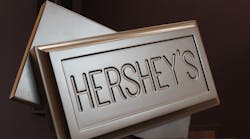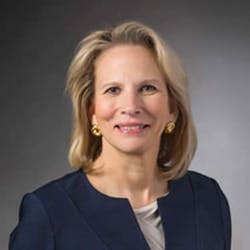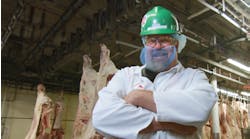What other food company has a town named after it? And an amusement park. And a charity. For that matter, has popular-enough brands that it can open freestanding stores devoted only to its products.
Hershey Co., perhaps more than any other food processor, remains close to its roots. While Conagra and at least half of Heinz moved to Chicago and Nestlé USA is now just outside the D.C. beltway, Hershey is still headquartered in the small, unincorporated Pennsylvania town that bears its name.
Hershey is no longer just a candy company, much less a chocolatier. Starting with the 2015 acquisition of Krave Pure Foods, a maker of meat jerky, the company has been intent on branching out into other categories within its familiar circle of snacking.
Krave didn’t really work out – the unit was sold back to its founder in 2020. But it was followed by the 2018 purchase of Amplify Snack Brands, owner of SkinnyPop popcorn and Paqui tortilla chips, and later that same year Pirates Brands, which makes Pirate’s Booty cheese puffs. After taking three years off, Hershey in 2021 bought Dot’s Pretzels LLC and Pretzels Inc. As a result, Hershey at the end of 2021 made salty snacks one of its three reporting segments.
Along the way, in addition to some small confectionary buys, Hershey in 2019 completed the acquisition of One Brands, a maker of low-sugar, high-protein nutrition bars.
Hershey embodies the three-legged foundation we look for in all top food & beverage companies: innovative product development, manufacturing and marketing. We’ll delve into Hershey’s product development and manufacturing processes in the following two stories. Hershey also gets high marks in all the criteria we look for in a Processor of the Year: financial success and visionary management, innovative product development, manufacturing prowess, industry leadership and commitment to environmental and social issues.
2021 was a stellar year
It was interesting to see how the pandemic affected the fortunes of food & beverage companies. For Hershey and most of the bigger snack and candy companies, it was a shot in the arm.
“Stuck at home with no place to go coupled with the stress of a worldwide pandemic … indulgent comfort foods provide an escape from increased stress levels and offer a simple splurge that is popular during challenging times,” wrote Darren Seifert in a late-2020 blog post for market research firm NPD Group.
“Pandemic-Inspired Behaviors Help Push U.S. Chocolate Market Past $27 Billion,” trumpeted a late-2021 headline from the National Confectioners Assn.
Of course “reward food” sales only got better as the pandemic got worse. While supply chain and manufacturing capacity issues forced smaller marketers out of business, companies with the wherewithal and brand recognition of Hershey were able to not only sell more but gain market share.
Hershey sales hit the $7 billion mark back in 2013 and grew every year but one in that decade (except 2015) to break the $8 billion mark in 2020. Last year, sales jumped 8.4% to reach an all-time high of $8.971 billion. Net income last year was $1.478 billion, also a record.
This year, Hershey is on trend to surpass last year’s sales and earnings. Through three quarters of 2022, sales were $7.767 billion and net income was $1.249 billion.
Those numbers led the company to increase its full-year guidance to the market for this year. Instead of 12-14% sales growth, Hershey now projects 14-15%; instead of earnings per share growth of 9-12%, they predict 11%-13%. They forecast adjusted earnings per share of $8.20-8.27.
Those kinds of surprises are pleasant ones to Wall Street analysts, who are used to surprise announcements in the opposite direction.
There is momentum on three fronts. North America confectionery sales were $2.236 billion in the third quarter of 2022, an increase of 10.4% versus the same period last year. Within what it calls refreshment, Hershey’s gum products increased 14.8%, driven by less mask-wearing.
North America Salty Snacks sales were $275 million in the third quarter of 2022, an increase of 87% versus the same period last year (due to acquisitions). All the brands -- Dot’s Homestyle Pretzels, Pretzels Inc., SkinnyPop, Pirate’s Booty – saw double-digit growth. With sales standing at $757 million through three quarters, salty snacks appears to be a billion-dollar business.
Hershey is less invested in global sales than its competitors, a factor that may have worked in its favor during the pandemic, supply chain problems, worldwide tensions and global currency fluctuations. Previous CEO J.P. Bilbrey pushed Hershey into international markets, a trend throughout the food industry in the 2010s. But when Michele Buck became CEO in 2016, she refocused the company on the North American market.
Which doesn’t mean Hershey has given up on the rest of the world. This past May, the company opened an R&D center in Malaysia that will serve as a central hub for innovations across the Asia-Pacific region. The company has two manufacturing plants in Mexico and one in Malaysia. Hershey’s international sales in the third-quarter 2022 increased 15.4% versus the same period last year to $218 million – meaning international soon could be a billion-dollar business, too.
A year of buying and selling
2021 was a busy year for acquisitions. Hershey started the year with a more traditional acquisition: Lily’s Sweets was a privately held company that sells a line of sugar-free and low-sugar confectionery products -- including dark and milk chocolate style bars, baking chips and peanut butter cups -- in the U.S. and Canada. Lily’s is expected to generate sales of more than $100 million.
Then came deeper dives into salty snacks. Dot’s unique pretzel products and cult following made it the fastest-growing brand in the pretzel category – although most, if not all, of the product was contract-manufactured.
Pretzels Inc. brought Hershey a product portfolio that includes filled, gluten-free and seasoned pretzels, as well as extruded snacks. Maybe more importantly, Pretzels Inc. also came with three manufacturing locations in Indiana and Kansas, giving Hershey the manufacturing expertise and manufacturing capabilities to support brand growth and future pretzel innovation.
Together, Pretzels and Dot’s are expected to generate annual sales of more than $300 million.
Late last year Hershey made a minority investment in Quinn, a snack-maker founded by a woman with social commitments and natural ingredients. Hershey's buy-in was part of a Series D round of funding for the upstart company, which makes microwave popcorn, pretzels and pretzel chips; sorghum is a key ingredient.
2021 also saw the divestiture of Lotte Shanghai Foods Co., a joint venture Hershey operated in China with Korean confectioner Lotte, which had been the victim of pressure from the Chinese government as its relations with South Korea soured.
Hershey's Iconic brands
“Hershey” as a brand is itself one of the most popular candy brands in the U.S. It encompasses the iconic milk chocolate bar as well as offshoots in almonds, dark chocolate (Special), Cookies ‘n’ Cream and Nuggets. The first Hershey Bar was sold in 1900. The iconic Hershey Kiss came along in 1907.
But the extension of the Hershey brand pales in comparison to what the company has done with Reese’s. The peanut butter cup is the top-selling candy brand in the U.S., its far-reaching trademark comprising an estimated $2.5 billion in sales.
Hershey has filled the original peanut butter-and-chocolate cup with cookie pieces, pretzels, potato chips and its own Reese’s pieces and cereal puffs. And they come in many sizes and shapes and for numerous special occasions and holidays. Many of the products are available in milk, dark and white chocolate.
The brand has such power it’s been licensed for cereals, a pudding-like dessert, peanut butter, dipped pretzels, an ice cream shell coating, snack mixes and snack bars. And it’s spawned its own sub-brands: Reese’s Fast Break and Reese’s Nutrageous. The Hershey website says there are more than 100 products bearing the Reese’s name.
The peanut butter cup was invented in the early 1920s by H.B. Reese, a Hershey employee, who started making candy in the basement of his Hershey home. He started his own company, and rather than squash him, Hershey supplied him with chocolate. In 1963, his six sons sold the business to Hershey Co.
Other Hershey chocolate brands include 5th Avenue, Almond Joy, BarkThins, Cadbury's (under license), Caramello, Heath Bar, Kit Kat, Krackel, Milk Duds, Mounds, Mr. Goodbar, NutRageous, Oh Henry!, PayDay, Rolo, Skor, Sweet Escapes, Symphony, Take5, Whatchmacallit, Whoppers, York, Zagnut and Zero.
Hershey remained a chocolate-only company until the 1996 acquisition of Leaf Inc., which added 40 brands, many non-chocolate ones like Jolly Rancher, Good & Plenty, Rainblo and Super Bubble. Some Nabisco brands were added in 2000. Now Hershey’s non-chocolate candy brands include Amazin' Fruit, Breathsavers, Bubble Yum, Chuckles, Heide, Ice Breakers, Luden's, Mauna Loa, Mr. Freeze, Nibs, Sour Dudes, Snacksters and Twizzlers.
What’s next for Hershey's?
Few American food or beverage companies have enjoyed a run like Hershey’s. With the hand of the Milton Hershey Trust upon it, it should remain forever independent. But when a charity and school depend upon your revenue for its operating budget, downturns may not be tolerated.
The addition of salty snacks is an interesting bet. Hershey struck at the right time, and the category remains hot. But that business line needs some rounding-out; perhaps with the addition of a potato chip company?
Diversification hasn’t always worked for Hershey. Starting in 1966, the company decided to corner the pasta market with acquisitions of San Giorgio Macaroni, Skinner Macaroni, American Beauty Macaroni, G&R Pasta, Ronzoni Foods, Ideal Macaroni and Mr. Weiss Noodle Co. Hershey even renamed itself Hershey Foods Corp. But even with a commanding position, pasta proved a declining and commoditized market, and Hershey sold the business in 1999.
“Five and a half years ago, when I became the CEO of Hershey, I had a vision that we could be more than a candy maker … to make Hershey a snacking powerhouse by expanding into the savory and better-for-you categories,” CEO Buck wrote in a recent Harvard Business Review. “Then we made it happen by streamlining our operations, bolstering our core, developing a more courageous culture and executing a series of diversifying acquisitions.
“We’ve learned to be more entrepreneurial, adaptable and agile. We’ve embraced disruption as an opportunity for growth. As a result, we have more than doubled our market [capitalization] and we’re approaching $10 billion in sales,” Buck continued. “We’re now well on our way to transforming Hershey from an iconic confection company to a leading snacking powerhouse.”



